Cleaved-Notch 1 (V1754) Polyclonal Antibody
- Catalog No.:YC0067
- Applications:WB;IF;IHC;ELISA
- Reactivity:Human;Mouse;Rat
- Target:
- Notch-1
- Fields:
- >>Endocrine resistance;>>Notch signaling pathway;>>Th1 and Th2 cell differentiation;>>Thyroid hormone signaling pathway;>>Prion disease;>>Human papillomavirus infection;>>Pathways in cancer;>>MicroRNAs in cancer;>>Breast cancer
- Gene Name:
- NOTCH1
- Protein Name:
- Neurogenic locus notch homolog protein 1
- Human Gene Id:
- 4851
- Human Swiss Prot No:
- P46531
- Mouse Gene Id:
- 18128
- Mouse Swiss Prot No:
- Q01705
- Rat Swiss Prot No:
- Q07008
- Immunogen:
- The antiserum was produced against synthesized peptide derived from human Notch 1. AA range:1735-1784
- Specificity:
- Cleaved-Notch 1 (V1754) Polyclonal Antibody detects endogenous levels of fragment of activated Notch 1 protein resulting from cleavage adjacent to V1754.
- Formulation:
- Liquid in PBS containing 50% glycerol, 0.5% BSA and 0.02% sodium azide.
- Source:
- Polyclonal, Rabbit,IgG
- Dilution:
- WB 1:500-2000, IHC 1:50-300, IF 1:50-300
- Purification:
- The antibody was affinity-purified from rabbit antiserum by affinity-chromatography using epitope-specific immunogen.
- Concentration:
- 1 mg/ml
- Storage Stability:
- -15°C to -25°C/1 year(Do not lower than -25°C)
- Other Name:
- NOTCH1;TAN1;Neurogenic locus notch homolog protein 1;Notch 1;hN1;Translocation-associated notch protein TAN-1
- Observed Band(KD):
- 110kD
- Background:
- notch 1(NOTCH1) Homo sapiens This gene encodes a member of the NOTCH family of proteins. Members of this Type I transmembrane protein family share structural characteristics including an extracellular domain consisting of multiple epidermal growth factor-like (EGF) repeats, and an intracellular domain consisting of multiple different domain types. Notch signaling is an evolutionarily conserved intercellular signaling pathway that regulates interactions between physically adjacent cells through binding of Notch family receptors to their cognate ligands. The encoded preproprotein is proteolytically processed in the trans-Golgi network to generate two polypeptide chains that heterodimerize to form the mature cell-surface receptor. This receptor plays a role in the development of numerous cell and tissue types. Mutations in this gene are associated with aortic valve disease, Adams-Oliver syndrome, T-cell acute lymphoblastic leukemia, chronic lymph
- Function:
- disease:Defects in NOTCH1 are a cause of aortic valve disease [MIM:109730]. The disorder consists of an early developmental defect in the aortic valve and a later de-repression of calcium deposition that causes progressive aortic valve disease. Calcification of the aortic valve is the third leading cause of heart disease in adults. The incidence increases with age, and it is often associated with a bicuspid aortic valve present in 1-2% of the population.,disease:NOTCH1 truncation is associated with T-cell acute lymphoblastic leukemia.,function:Functions as a receptor for membrane-bound ligands Jagged1, Jagged2 and Delta1 to regulate cell-fate determination. Upon ligand activation through the released notch intracellular domain (NICD) it forms a transcriptional activator complex with RBP-J kappa and activates genes of the enhancer of split locus. Affects the implementation of differentiat
- Subcellular Location:
- Cell membrane ; Single-pass type I membrane protein .; [Notch 1 intracellular domain]: Nucleus . Following proteolytical processing NICD is translocated to the nucleus. Nuclear location may require MEGF10. .
- Expression:
- In fetal tissues most abundant in spleen, brain stem and lung. Also present in most adult tissues where it is found mainly in lymphoid tissues.
DT7 peptide-modified lecithin nanoparticles co-loaded with γ-secretase inhibitor and dexamethasone efficiently inhibit T-cell acute lymphoblastic leukemia and reduce gastrointestinal toxicity Cancer Lett. 2022 May;533:215608. IF Mouse bone marrow
MiR‐199b‐5p inhibits osteogenic differentiation in ligamentum flavum cells by targeting JAG1 and modulating the Notch signalling pathway. JOURNAL OF CELLULAR AND MOLECULAR MEDICINE 2016 Dec 13 WB Human 1:500 ligamentum flavum cell
LncRNA ROR promotes proliferation of endometrial cancer cells via regulating Notch1 pathway.. European Review for Medical and Pharmacological Sciences Eur Rev Med Pharmaco. 2020 Jun;24(11):5970-5978 WB Human HEC-1A cell
Notch signaling pathways in human thoracic ossification of the ligamentum flavum. JOURNAL OF ORTHOPAEDIC RESEARCH J Orthop Res. 2016 Aug;34(8):1481-1491 IHC Human 1:200 ossification of the ligamentum flavum (OLF) tissue
Noninvasive Evaluation of the Notch Signaling Pathway via Radiomic Signatures Based on Multiparametric MRI in Association With Biological Functions of Patients With Glioma: A Multi-institutional Study JOURNAL OF MAGNETIC RESONANCE IMAGING Wenzhen Zhu MD, PhD IHC Human
Nanocarrier of Pin1 inhibitor based on supercritical fluid technology inhibits cancer metastasis by blocking multiple signaling pathways Regenerative Biomaterials Dayun Yang WB Human HuH7 cell,HepG2 cell
m6A-Dependent Modulation via IGF2BP3/MCM5/Notch Axis Promotes Partial EMT and LUAD Metastasis. Junchao Cai IHC,IF Human 1:200 lung adenocarcinoma (LUAD) tissue A549 cell,H1975 cell
Vitamin D/vitamin D receptor protects intestinal barrier against colitis by positively regulating Notch pathway Frontiers in Pharmacology Li Yanni IF,WB Mouse,Human 1:100,1:1000 colonic tissue Caco-2 cell
- June 19-2018
- WESTERN IMMUNOBLOTTING PROTOCOL
- June 19-2018
- IMMUNOHISTOCHEMISTRY-PARAFFIN PROTOCOL
- June 19-2018
- IMMUNOFLUORESCENCE PROTOCOL
- September 08-2020
- FLOW-CYTOMEYRT-PROTOCOL
- May 20-2022
- Cell-Based ELISA│解您多样本WB检测之困扰
- July 13-2018
- CELL-BASED-ELISA-PROTOCOL-FOR-ACETYL-PROTEIN
- July 13-2018
- CELL-BASED-ELISA-PROTOCOL-FOR-PHOSPHO-PROTEIN
- July 13-2018
- Antibody-FAQs
- Products Images
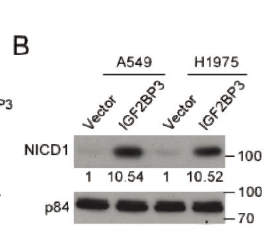
- m6A-Dependent Modulation via IGF2BP3/MCM5/Notch Axis Promotes Partial EMT and LUAD Metastasis. Junchao Cai IHC,IF Human 1:200 lung adenocarcinoma (LUAD) tissue A549 cell,H1975 cell
.jpg)
- Zhao, Feng, et al. "Novel mouse miRNA Chr13_novelMiR7354-5p improves bone-marrow-derived mesenchymal stem cell differentiation into insulin-producing cells." Molecular Therapy-Nucleic Acids 19 (2020): 1110-1122.
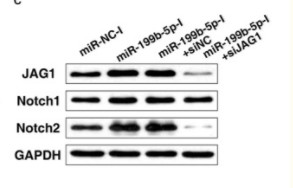
- Qu, Xiaochen, et al. "MiR‐199b‐5p inhibits osteogenic differentiation in ligamentum flavum cells by targeting JAG1 and modulating the Notch signalling pathway." Journal of cellular and molecular medicine 21.6 (2017): 1159-1170.
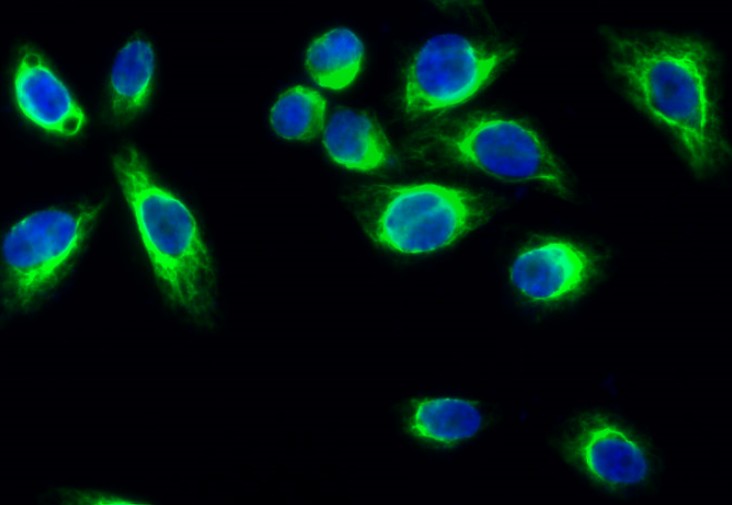
- Immunofluorescence analysis of Hela cell. 1,Cleaved-Notch 1 (V1754) Polyclonal Antibody(green) was diluted at 1:200(4° overnight). 2, Goat Anti Rabbit Alexa Fluor 488 Catalog:RS3211 was diluted at 1:1000(room temperature, 50min). 3 DAPI(blue) 10min.
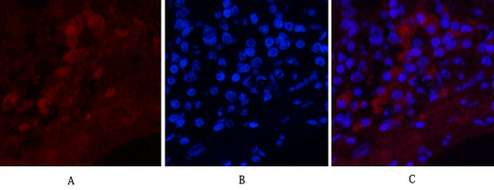
- Immunofluorescence analysis of Human-lung-cancer tissue. 1,Cleaved-Notch 1 (V1754) Polyclonal Antibody(red) was diluted at 1:200(4°C,overnight). 2, Cy3 labled Secondary antibody was diluted at 1:300(room temperature, 50min).3, Picture B: DAPI(blue) 10min. Picture A:Target. Picture B: DAPI. Picture C: merge of A+B
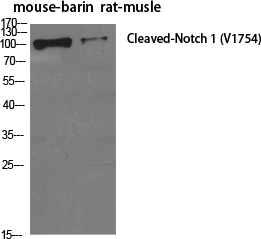
- Western Blot analysis of various cells using Cleaved-Notch 1 (V1754) Polyclonal Antibody diluted at 1:500
.jpg)
- Western Blot analysis of KB cells using Cleaved-Notch 1 (V1754) Polyclonal Antibody diluted at 1:500
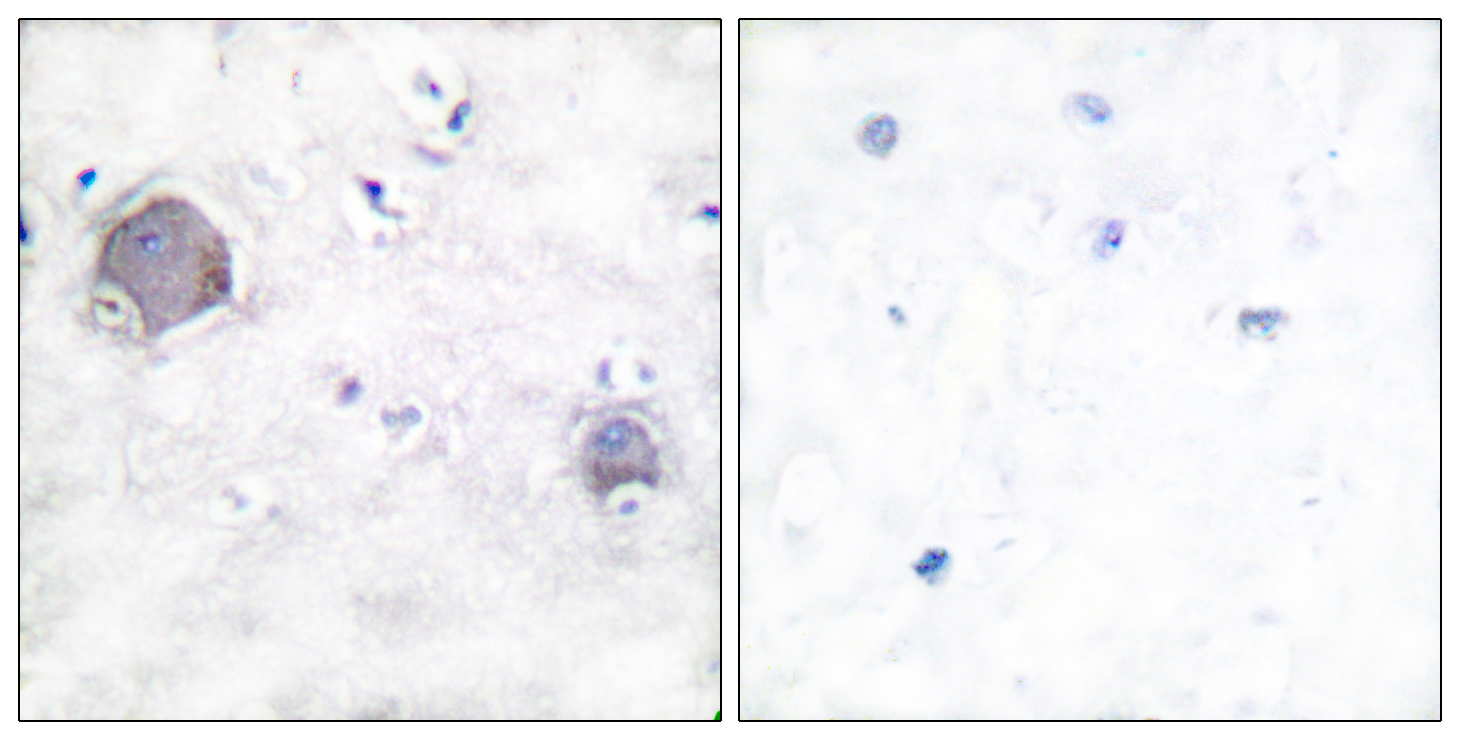
- Immunohistochemistry analysis of paraffin-embedded human brain tissue, using Notch 1 (Cleaved-Val1754) Antibody. The picture on the right is blocked with the synthesized peptide.



